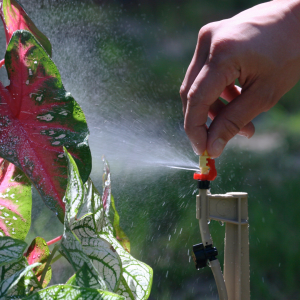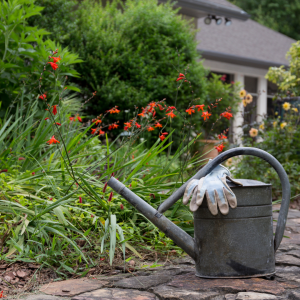
Hey, you! Are you tired of waking up early to water your plants? Sick of high water and electric bills from heavy duty irrigation all year round? Fed up with constantly paying for the latest and greatest way to get rid of plant pests? Perhaps the thought of yellowing or wilted leaves keeps you up at night…
Stop wasting your precious time, energy, and resources on a high maintenance landscape. Consider installing drought-tolerant, low-maintenance plants to accent your home instead. There are many to choose from in Florida, and each has something special to offer, whether it’s vibrant, showy flowers, shade for your backyard lounging, edible fruit, or a great nectar source for your local pollinators.
Remember, Sarasota County has a Water Efficient Landscape Ordinance, meaning that you should be doing your best to keep at least 50% of your landscape as a low irrigation zone. While this ordinance applies to new construction and extensive remodel projects, it is important for all of us to take steps towards lowering our outdoor water use. Ornamental garden beds can be fitted with micro-irrigation, which uses much less water than traditional sprinkler systems. With the proper planning, some garden beds can even go without regular irrigation once the plants are established. This means that plants in this area of your landscape require very little supplemental watering throughout the year.
Welcome to our Low Maintenance Landscaping blog series. This series will include guides to groundcovers, grasses, herbs, ferns, shrubs, succulents, trees and palms, and vines that will do well with minimal watering and fertilizer in Sarasota County .
Be on the lookout for our upcoming blogs, which will be linked here when published.
- Low-Maintenance Landscaping: Introduction
- Low-Maintenance Landscaping: Groundcovers
- Low-Maintenance Landscaping: Ornamental Grasses
- Low-Maintenance Landscaping: Trees and Palms
- Low-Maintenance Landscaping: Ferns
- Low-Maintenance Landscaping: Forbs (coming soon)
- Low-Maintenance Landscaping: Shrubs (coming soon)
- Low-Maintenance Landscaping: Succulents (coming soon)
- Low-Maintenance Landscaping: Vines (coming soon)
Keep reading to learn about some ways you can reduce your future workload when it comes to your garden or landscape.
Tips for a Low-Maintenance Landscape
Several of these tips are principles of Florida-Friendly Landscaping™ and if you implement them all, you will likely qualify for a Sarasota County Landscape Recognition.

Mulching
A healthy plant bed should have around 2 to 3 inches of mulch. Over time, mulch will break down and provide important nutrients to your plants. Beyond that, it helps insulate your plants’ roots in the cooler months of the year and retains moisture in the soil. Mulch can also deter the growth of weeds and help prevent disease. Mulch is truly miraculous! There are many kinds to choose from depending on how you would like your landscape to look. To help keep mulch inside of your beds, consider adding decorative edging.
Weeding
Every once in a while, unwanted plants may enter your beds and compete for resources with your precious plant babies. The easiest, most cost-effective way to rid your landscape of weeds is to hand pull them. Just make sure to pull out all of the plant, including the roots. Otherwise, it might grow back!

Micro-Irrigation
Many of the plants listed in this blog series will not require much, if any, irrigation once established. That said, there may be parts of the year with significant drought, and during that time, you can make use of a micro-irrigation system. Installation is relatively inexpensive and easy to do, and the system can be connected to a variety of water sources. Whether you are retrofitting an existing irrigation system or putting one in at the hose bib, you can be sure that your plants are getting the water they need when they need it most. Be sure to turn off your drip irrigation in the rainy season, so you don’t overwater.
Minimize Fertilizer Use
Too much fertilizer, especially if it’s quick-release, can encourage lots of new growth. While that might seem ideal, it actually means a lot more watering and work for you! Aim to supplement your soil with grass clippings or compost to provide a more stable, sustainable source of nutrients. If you feel you need to add supplemental fertilizer, choose an option with at least 50% of its nitrogen content coming from slow-release (insoluble) sources. This information should be on the back label of the fertilizer’s packaging. You should also try to choose a product without added phosphorus unless a soil test shows that your soil is deficient in this nutrient. Many of the plants listed in this series can do well without supplemental fertilizer. Be sure to only apply nitrogen fertilizer outside of our county’s restricted season, which is June 1 to September 30.

Proper Planting
When it comes to actually putting your plant in the ground, making sure that you made a large and deep enough hole is essential. You want to guarantee that the plants’ roots will be be protected by the soil and have enough room to spread naturally. A well-established plant is a happy and healthy plant, which will naturally need less water!
Right Plant, Right Place
The most important rule of thumb when it comes to creating a low maintenance landscape is to put your choice of plant in the right area of your landscape. Many of the plants we’ll discuss in this series can thrive in sandy soils without much water, but they still need to have the right light and soil conditions.
More on right plant, right place
For a more comprehensive list of plants for your landscape, visit https://ffl.ifas.ufl.edu/plants/.
 2
2
